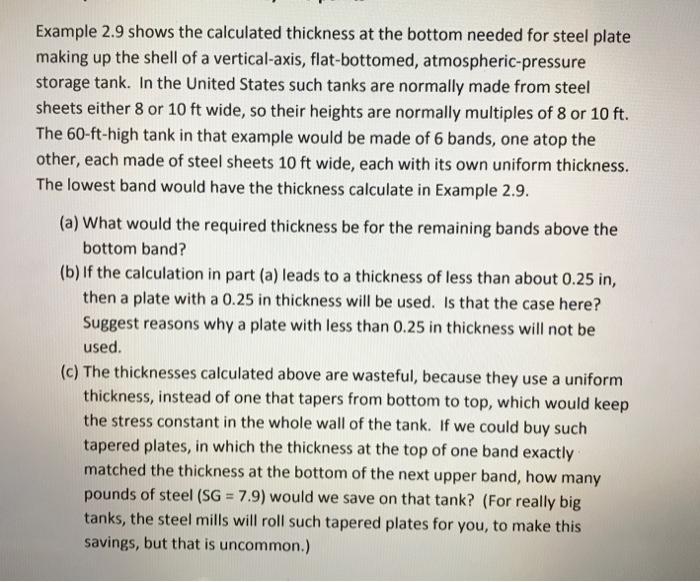Answered step by step
Verified Expert Solution
Question
1 Approved Answer
Show all work Example 2.9 shows the calculated thickness at the bottom needed for steel plate making up the shell of a vertical-axis, flat-bottomed, atmospheric-pressure
Show all work 
Example 2.9 shows the calculated thickness at the bottom needed for steel plate making up the shell of a vertical-axis, flat-bottomed, atmospheric-pressure storage tank. In the United States such tanks are normally made from steel sheets either 8 or 10ft wide, so their heights are normally multiples of 8 or 10ft. The 60 -ft-high tank in that example would be made of 6 bands, one atop the other, each made of steel sheets 10ft wide, each with its own uniform thickness. The lowest band would have the thickness calculate in Example 2.9. (a) What would the required thickness be for the remaining bands above the bottom band? (b) If the calculation in part (a) leads to a thickness of less than about 0.25 in, then a plate with a 0.25 in thickness will be used. Is that the case here? Suggest reasons why a plate with less than 0.25 in thickness will not be used. (c) The thicknesses calculated above are wasteful, because they use a uniform thickness, instead of one that tapers from bottom to top, which would keep the stress constant in the whole wall of the tank. If we could buy such tapered plates, in which the thickness at the top of one band exactly matched the thickness at the bottom of the next upper band, how many pounds of steel (SG = 7.9) would we save on that tank? (For really big tanks, the steel mills will roll such tapered plates for you, to make this savings, but that is uncommon.) 
Step by Step Solution
There are 3 Steps involved in it
Step: 1

Get Instant Access to Expert-Tailored Solutions
See step-by-step solutions with expert insights and AI powered tools for academic success
Step: 2

Step: 3

Ace Your Homework with AI
Get the answers you need in no time with our AI-driven, step-by-step assistance
Get Started


